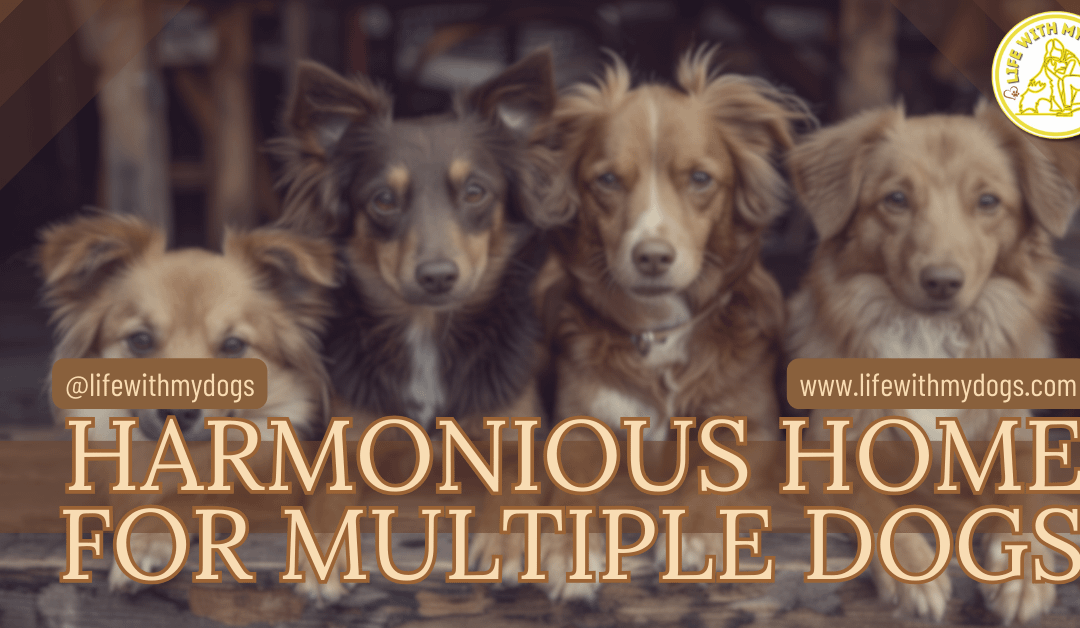LifeWithMyDogs is supported by our audience. When you purchase through one of our links, we may earn a small affiliate commission. As an Amazon Associate I earn from qualifying purchases. Your cost is not affected.
**********
Creating a harmonious home for multiple dogs is both an art and a science. Imagine a household where tails wag in unison, where barks are joyful greetings rather than territorial disputes, and where every furry friend feels secure and loved. Achieving this idyllic environment might seem daunting, but with the right strategies, it’s entirely possible.
In this guide, we’ll explore practical tips and expert advice to help you foster a peaceful, balanced, and happy home for your canine companions. Whether you’re a seasoned dog owner or welcoming a new pup into a pack, this article will provide you with the insights you need to create a harmonious haven for all your dogs.
Creating a Harmonious Home for Multiple Dogs: Tips for Peaceful Coexistence

Living with multiple dogs can bring so much joy and companionship. But it also comes with challenges. Creating a harmonious home for multiple dogs requires consistent training, careful management of resources, and understanding each dog’s unique needs.
When I first brought home a second dog, I quickly learned the importance of introducing them slowly and supervising all interactions. It took time and patience, but now my dogs are best buddies. I make sure to give each one individual attention and have separate feeding areas to avoid conflicts.
Training is key for a peaceful multi-dog household. I teach my dogs to respond to cues as a group, which helps keep everyone under control. I also keep them in separate rooms when I’m not home to prevent any issues. With some thoughtful planning, having multiple dogs can be a wonderful experience.

Key Takeaways
- Recognizing how dogs express themselves through body language, vocalizations, and scents is essential for managing interactions. Understanding these behaviors helps prevent conflicts and fosters a peaceful environment.
- Dogs have natural territorial instincts that can lead to conflicts over resources like food, toys, and sleeping spots. Providing each dog with their own designated spaces and supervising interactions, especially during feeding times, can help minimize disputes.
- Introducing new dogs to the pack should be done gradually and in neutral spaces. Controlled first meetings, close monitoring of body language, and short, positive interactions are crucial for smooth introductions and preventing aggression.
- Consistent training and establishing clear rules are key to maintaining harmony. Teaching basic commands, reinforcing positive behavior, and creating structured routines for feeding, walks, and playtime help reduce stress and competition among the dogs.
- Balancing individual attention with group bonding activities is important for each dog’s well-being. One-on-one time, solo walks, and special moments ensure each dog feels valued, while group activities like walks and play sessions strengthen their bond and improve social skills.

Understanding Canine Behavior
Dogs communicate and interact in unique ways. Knowing how they express themselves, mark their space, and form social structures helps in creating a harmonious home for multiple dogs, ensuring a peaceful multi-dog environment.

Communication Among Dogs
Dogs use body language, vocalizations, and scents to talk to each other. Tail wagging can mean different things depending on the position and speed. A high, stiff tail often signals aggression, while a low, slow wag shows submission.
Barks, growls, and whines are important vocal cues. I’ve noticed my dogs use different pitches and lengths to express various emotions. Scent marking is another key way dogs communicate. They leave their smell on objects and areas to claim territory or share information with other dogs.
Territorial Instincts
Dogs naturally want to protect their space and resources. In a multi-dog home, this can lead to conflicts over toys, food, or sleeping spots. I’ve found it helpful to give each dog their own:
- Bed
- Food and water bowls
- Toys
- Quiet space
Managing the environment is crucial. I make sure there are enough resources for everyone and supervise interactions, especially during feeding times.
Pack Hierarchy
Dogs often form a social structure similar to wolf packs. There’s usually an “alpha” dog who takes charge, while others have more submissive roles. I watch for signs of dominance like:
- Standing tall
- Placing paws on another dog’s back
- Pushing to be first through doors
Submissive behaviors include:
- Lowering the body
- Avoiding eye contact
- Exposing the belly
Understanding these roles helps me manage interactions and prevent fights. I make sure to treat all my dogs equally to avoid reinforcing unhealthy power dynamics.
Preparing Your Home for Multiple Dogs
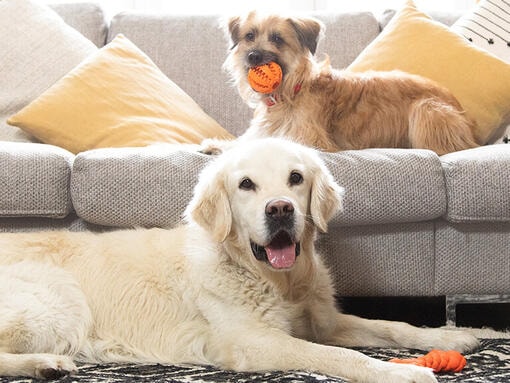
Getting your home ready for multiple dogs takes some planning. In this guide on creating a harmonious home for multiple dogs, I’ll share tips on creating spaces for each pup and setting up safe areas they can retreat to when needed.
Designating Personal Spaces
I always make sure each dog has their own bed, food bowl, and toys. This helps prevent fights over resources. I place beds in quiet corners where dogs can relax without being bothered.
For mealtimes, I feed dogs in separate rooms or use crates. This stops food guarding issues before they start. I also give each dog their own toy box. This lets them pick what they want to play with. Sharing toys can cause conflict, so having enough for everyone is key.
Safe Zones and Escape Routes
I create “timeout” spaces where dogs can go to be alone. This might be a crate, a gated-off room, or a cozy corner. I make sure there are multiple exits from each room. This lets dogs avoid each other if needed.
Baby gates are great for separating dogs when things get tense. I use them to block off certain areas of the house. I also set up high places like cat trees or window perches. Small dogs can use these to get away from bigger ones. Outdoor spaces need safe zones too. I add dog houses or covered areas in the yard where pups can retreat.
Here’s an additional video on creating a harmonious home for multiple dogs.
By: Glamorous Pups
Did You Know?
It has been found that introducing dogs in a neutral area works well. Careful attention is paid to their interactions, ensuring that each dog receives individual attention. Treats are used to reward friendly behavior, helping to create positive associations between the dogs.
Selecting Compatible Canine Companions
Picking the right dogs to live together is key for a happy multi-dog home. I’ll share tips on matching personalities and considering size differences to help your pack get along.
Assessing Temperaments
When I’m looking at dog temperaments, I focus on energy levels and social skills. In creating a harmonious home for multiple dogs, I try to pair dogs with similar activity needs. A lazy couch potato might not mesh well with a high-energy pup who wants to play all day.
I also look at how dogs interact with others. Some are naturally social butterflies, while others prefer their own space. I aim to match dogs with compatible social styles. Past experiences matter too. If a dog has had bad run-ins with certain types of dogs, I’m careful about those pairings.
Consideration of Size and Breed
Size differences can affect how dogs get along. I’m cautious about mixing very small and large breeds. A big dog might accidentally hurt a tiny one during play. Some breeds have strong instincts that could clash.
For example, I’m careful about putting high-prey drive dogs with small, “prey-like” breeds. Age is another factor I consider. An energetic puppy might annoy an older dog who prefers peace and quiet. I also think about exercise needs. Pairing a lazy Bulldog with a tireless Border Collie could lead to frustration for both.
The Introduction Process
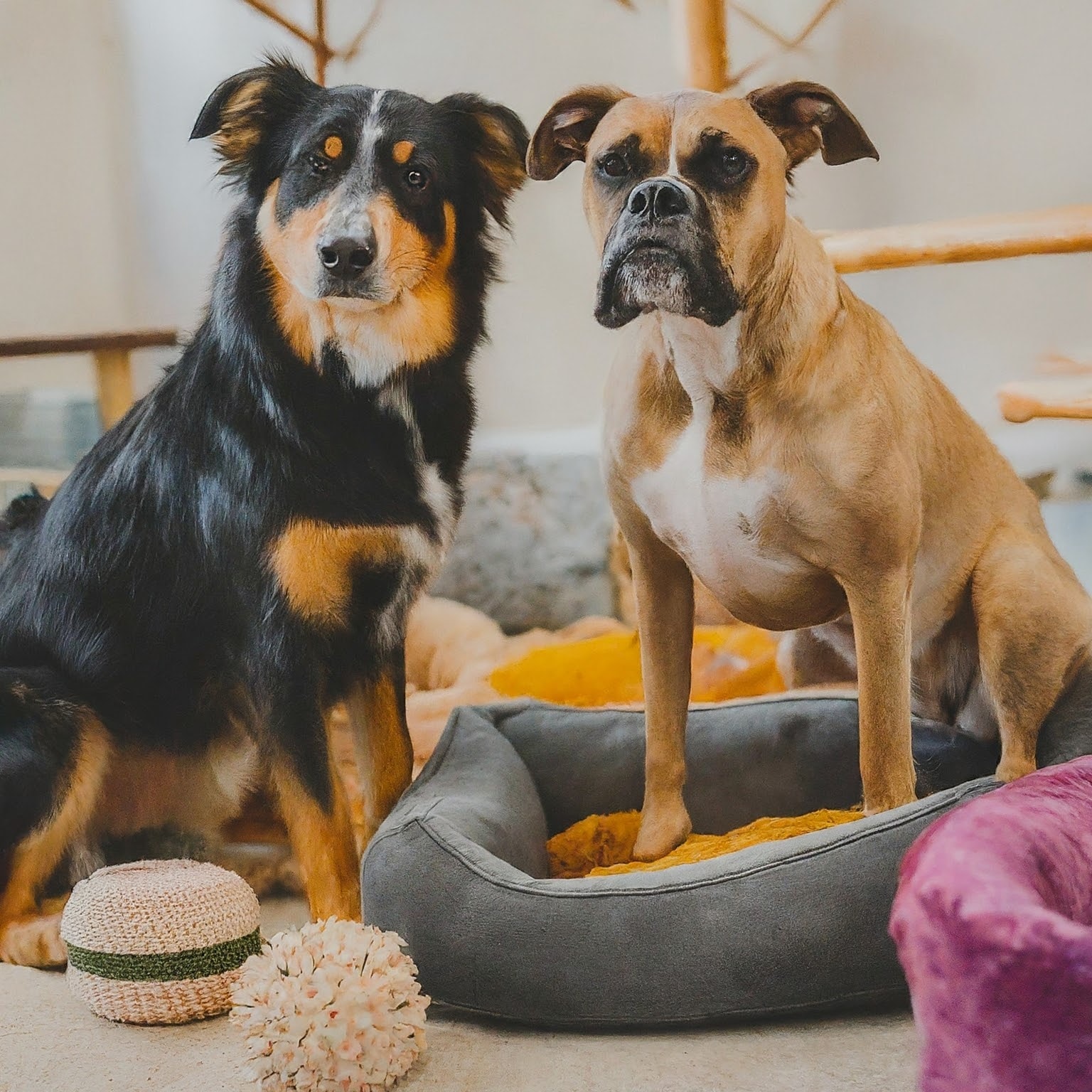
Bringing new dogs together takes patience and care. In the process of creating a harmonious home for multiple dogs, I’ve found that focusing on controlled first meetings and watching how the dogs interact is key. Here’s what I recommend for a smooth introduction:
Initial Meetings
I always start introductions in a neutral space. A quiet park or fenced yard works well. I keep both dogs on leashes at first. This gives me control while letting them see and smell each other from a safe distance.
I watch their body language closely. Wagging tails and playful bows are good signs. If I see raised hackles or growling, I calmly separate them and try again later. Short meetings are best at first. I aim for 5-10 minutes, ending on a positive note. I give lots of praise and treats to both dogs for calm behavior.
Monitoring Interactions
As the dogs get more comfortable, I allow more freedom. I might drop the leashes but leave them attached, so I can quickly regain control if needed. I keep a close eye on their play style. Some rough-housing is normal, but I step in if one dog seems overwhelmed. I make sure both dogs have a chance to be “on top” during play.
I watch for resource guarding. This can happen with toys, food, or even people. If I see signs of tension, I remove the item causing the problem. Quiet time is important too. I make sure each dog has a safe space to rest away from the other. This helps prevent overstimulation and conflicts.
Training for Cohabitation
Training is key for dogs to live together peacefully. It helps set clear expectations and creates a calm environment for everyone.
Establishing Rules and Boundaries
I start by teaching each dog basic commands like sit, stay, and come. This gives me control and helps prevent conflicts when creating a harmonious home for multiple dogs. I make sure all dogs know their designated spots for eating, sleeping, and playing.
I use positive reinforcement to reward good behavior. Treats and praise work wonders! I also set up clear routines for feeding, walks, and playtime. This structure helps reduce stress and competition. I teach my dogs to “leave it” when I’m giving attention to another pup. This prevents jealousy issues. I also make sure each dog gets one-on-one time with me every day.
Consistency Across All Dogs
I apply the same rules to all my dogs, no matter their age or size. This prevents confusion and ensures fairness. I use the same commands and hand signals for everyone. When training as a group, I start with one dog at a time. Then I slowly add more dogs to the mix. This helps them learn to focus even with distractions.
I involve all family members in training. We agree on the rules and stick to them. This consistency helps the dogs understand what’s expected. I also make sure to socialize my pack together. We go on group walks and have playdates with other dogs. This improves their social skills and strengthens their bond.
Feeding and Nutrition

Feeding multiple dogs can be tricky, but with the right approach, it’s totally doable. In the journey of creating a harmonious home for multiple dogs, I’ve found that setting up a good routine and preventing fights over food are key.
Scheduling and Individual Diets
I always feed my dogs at the same times each day. It keeps them happy and helps avoid upset tummies. Some of my pups need special food, so I’m careful to give each one the right diet. Different types of food may be needed if one dog has health issues or is a different age.
I make sure to measure portions carefully. Too much food can lead to weight gain, while too little might leave them hungry. I keep water bowls full and clean. Fresh water is super important for all my furry friends.
Preventing Food Aggression
To stop fights over food, I feed each dog in a separate area. This helps them feel safe while eating. I never let them steal from each other’s bowls. I stay nearby during mealtimes to keep an eye on things. If a dog finishes early, I guide them away from the others who are still eating.
For treats, I make sure everyone gets their fair share. I hand them out one by one, so no one feels left out. If I notice any growling or snapping around food, I work on training right away. Positive reinforcement helps a lot in teaching them to be calm around food.
Here’s an additional video that offers practical tips for feeding multiple dogs effectively:
By: Curtis Craig
Ensuring Adequate Exercise
Exercise is key for happy, healthy dogs in a multi-dog home. I’ll share some great ways to keep your pack active and fit, both together and individually.
Individual and Group Activities
I like to mix up individual and group exercise for my dogs. When it comes to creating a harmonious home for multiple dogs, solo activities play a crucial role. I take each dog on separate walks or runs, giving me valuable one-on-one time with each pup. I also play fetch or do agility training with them individually, ensuring that each dog feels special and attended to.
For group activities, I love taking all my dogs to a fenced area where they can run and play together. Group training classes are another fun option. Sometimes we go on hikes as a pack. I make sure to adjust exercise levels based on each dog’s age and energy. My older dog gets gentler exercise, while my young pup needs more intense workouts. Mixing it up keeps things interesting for everyone!
Healthcare Considerations
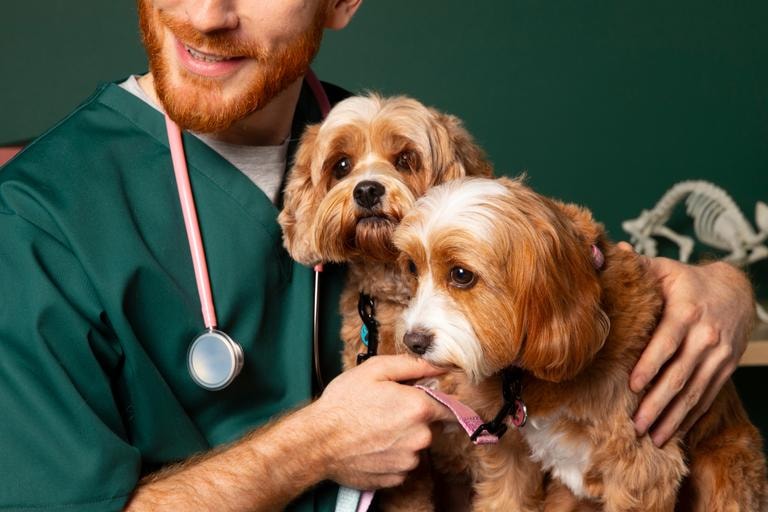
Taking care of multiple dogs’ health needs proper planning and attention. In this guide on creating a harmonious home for multiple dogs, I’ll cover key aspects of keeping your pack healthy and happy.
Routine Check-Ups and Vaccinations
I make sure to schedule regular vet visits for all my dogs. Each dog gets a yearly check-up to catch any issues early. I keep a calendar to track when each pup is due for shots. Vaccinations are crucial for a multi-dog home. I work with my vet to create a custom vaccine plan for each dog based on their age, health, and lifestyle.
Core vaccines like rabies are a must for all. I also pay attention to each dog’s teeth. Regular brushing at home and professional cleanings help prevent dental problems. This saves money in the long run and keeps my dogs comfortable.
Parasite Control
Fleas, ticks, and worms can spread quickly in a multi-dog household. I use year-round prevention for all my dogs to keep these pests at bay. I pick a flea and tick treatment that works for all my dogs’ sizes and ages. Some options protect against heartworms too, which is a bonus.
For intestinal worms, I follow my vet’s deworming schedule. I also pick up poop promptly to prevent worm eggs from spreading in my yard. I check my dogs for ticks after walks in wooded areas. This quick habit helps catch any hitchhikers before they cause trouble.
Managing Multi-Dog Dynamics
Living with multiple dogs takes some extra care and attention. I’ve found that resolving conflicts quickly and supporting older dogs are key to keeping the peace in creating a harmonious home for multiple dogs. Here are some tips I’ve learned for handling these important aspects of a multi-dog home.
Resolving Conflicts
When dogs argue, I step in right away. I use a firm but calm voice to interrupt squabbles before they escalate. Separating the dogs for a short “time out” often helps cool tempers. I make sure each dog has their own special items like beds, toys, and food bowls. This cuts down on fights over resources. I also give each dog one-on-one time with me every day. This reduces jealousy.
Positive reinforcement works wonders. I reward my dogs when they play nicely together. Treats, praise, and pets go a long way in teaching good behavior. If fights keep happening, I look for the cause. Sometimes a health issue or change in routine can trigger problems. Talking to my vet often helps sort things out.
Supporting Aging Dogs
As dogs get older, they need extra TLC. I make sure my senior pups have comfy beds in quiet spots away from the action. This gives them a place to rest undisturbed. I keep an eye on how younger dogs interact with older ones. Sometimes I need to step in if play gets too rough. Short, gentle play sessions are best for seniors.
Regular vet checks are a must for aging dogs. I watch for signs of pain or illness that might affect their mood. Medications can often help keep seniors comfortable and social. I adjust my home to help older dogs get around. Non-slip mats on slick floors and ramps for stairs make a big difference. With some extra care, senior dogs can stay happy members of the pack.
Creating a Lasting Bond
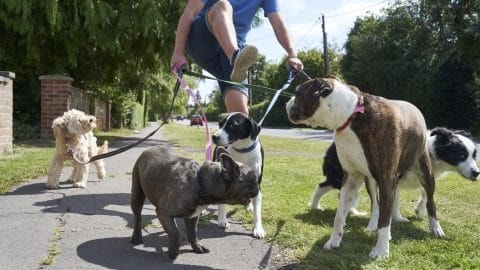
Building strong connections between your dogs is key. It helps create a happy home where all your furry friends get along. I’ll share some fun group activities and tips for giving each dog special attention.
Group Bonding Activities
I love taking my dogs on group walks as part of creating a harmonious home for multiple dogs. It’s a great way for them to spend time together and burn energy. I also set up playdates with other friendly dogs. This helps my pups learn how to play nicely with others.
I play games that include all my dogs, like hide-and-seek or fetch. It’s fun to watch them work as a team. Sometimes, I create obstacle courses in the backyard. My dogs have a blast running through tunnels and jumping over small hurdles together. Training sessions with all my dogs at once are also helpful. I teach them to sit, stay, and come as a group. This builds teamwork and makes them listen better.
Individual Attention and Love
Even in a multi-dog home, I make sure each of my pups gets one-on-one time with me. I set aside special moments for each dog every day. This might be a quick cuddle session or a short training game. I take each dog on solo walks sometimes. It gives us a chance to bond without distractions. During these walks, I practice commands and give lots of praise.
I also create special spaces for each dog in my home. Each pup has their own bed and toys. This helps them feel secure and loved. I make sure to give equal attention and treats to avoid jealousy between my dogs.
Achieving a Harmonious Multi-Dog Home: The Rewarding Journey of Patience and Understanding
Creating a harmonious home for multiple dogs is a rewarding journey that requires patience, dedication, and an understanding of canine behavior. By implementing consistent training, proper resource management, and individualized attention, you can foster a peaceful and joyful environment for your furry companions. Understanding each dog’s unique needs and behaviors allows you to address conflicts and support their well-being effectively.

With thoughtful planning and attention to detail, living with multiple dogs can be a wonderful experience filled with love and companionship. By ensuring each dog feels secure, valued, and understood, you create a balanced household where every pup thrives. Ultimately, the joy of seeing your dogs interact happily and harmoniously is a testament to the effort and care you’ve invested in their lives.
Frequently Asked Questions
What Are the Best Strategies for Potty Training Several Dogs Simultaneously?
I use a consistent schedule for all dogs. I take them out at the same times each day. I praise and reward each dog individually when they go potty outside. This reinforces good behavior for all of them.
What is the Recommended Number of Dogs for One Household?
I think there’s no set rule. It depends on the space, time, and resources available. I consider factors like the size of my home, my daily schedule, and my ability to care for each dog’s needs.
How Can You Effectively Crate Train More Than One Dog?
I give each dog their own crate. This prevents resource guarding and ensures they have a safe space. I make crate time positive by offering treats and toys. I slowly increase crate time for all dogs together.
Embark on an Adventure in the Pet Lover’s Paradise!
Dive into a world of furry friends and fantastic finds by connecting with us on social media! Immerse yourself in captivating content insightful product reviews, and become a part of a vibrant community.
Instagram: lifewithmydogs2 Follow us on Instagram for an overflow of heartwarming snapshots and exciting pet escapades!
Pinterest:lifewithmydogs2 Explore a treasure trove of pet inspiration and ideas on Pinterest, where each pin leads you to creative possibilities!
Facebook: 1LWMD Like us on Facebook to keep your finger on the pulse of all pets – from heartwarming stories to the latest pet gear trends!
Twitter: LifeWithMyDogs9 Join the conversation on Twitter, where you can chirp away about the newest pet happenings and stay ahead of the pack with the latest pet trends!

